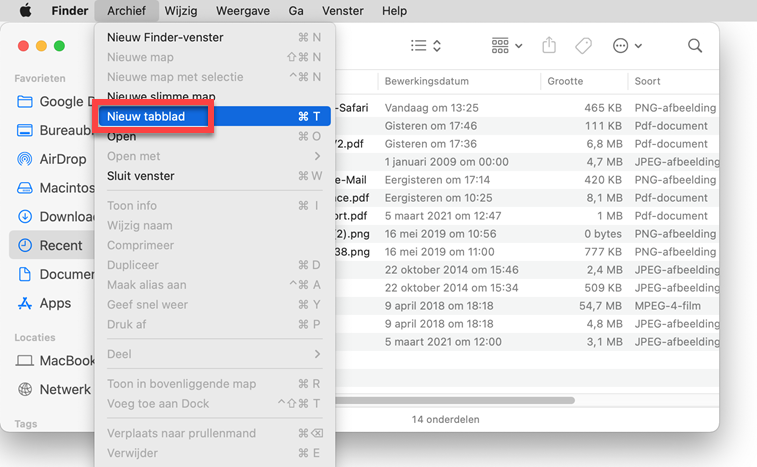Open Finder
Opening Finder is very easy, as it already has an icon for it on the Dock. Click this icon (a smiling face) on the far left of the Dock to launch Finder.
The look of Finder
The Finder window is divided into left and right panes. This actually works exactly like Windows Explorer: on the left you indicate which folder you want to navigate to and then the contents of that folder are shown on the right.
By default, Finder opens with the ‘Recent’ option, where the most recently edited files are displayed below each other.
Finder, left pane: Favorites
This section contains shortcuts to folders and/or items that you are likely to use frequently, such as Desktop, Documents, Apps, Downloads, and so on.
Finder, left pane: Locations
This section will not be visible to everyone. However, if your computer is part of a network, these devices will be shown here. You will also find external storage media here, such as a connected USB stick or hard drive.
Open program via Finder
You can also launch applications using Finder. You click on the option apps (macOS 10.15 Catalina and above) or Programs (macOS 10.14 Mojave and earlier) in the left pane navigation. Then double-click on a program’s name to launch it.
Another way to launch a program is directly from your Dock (the bar at the bottom of your screen).
Working with tabs
From the OS X 10.9 Mavericks operating system, Finder supports the use of tabs, as you are used to from your internet browser. Tabs allow you to have multiple folders open side by side within the Finder. This is useful, for example, if you want to move a file from one folder to another.
By default, the Finder opens with one window, with no tabs. Here’s how to open a new tab:
- Click in the menu bar at the top Archive.
- click on New tab.

- A new tab will open with the “Recents” folder. You can now browse to different folders in the Finder in both tabs.
- If you want to open an extra tab, click on the plus sign to the right of the right-most tab
 . A new tab will open on the right. If you want to close a tab, click on the cross on the left of the tab
. A new tab will open on the right. If you want to close a tab, click on the cross on the left of the tab  .
.
Navigating Finder
Perhaps you are not looking for a program, but for something completely different. There are then four views to navigate through the Finder: Symbols, List, Columns, and Gallery. You can find these options by clicking the two arrows icon at the top.
Navigate: Symbols
This view shows an icon overview of the contents of a folder. This is not the most compact view, but it is useful if you are visually inclined.
Navigate: List
This is the most compact view in which you can see, among other things, name, editing date, size, etc. of the files and can also sort the files accordingly.
Navigate: Columns
‘Columns’ opens a new column for each subfolder you click so that you can easily see how deep you are in a folder structure.
Navigate: Galerie
Gallery displays a large file containing a ribbon of other files in the folder. This view is ideal for viewing images.